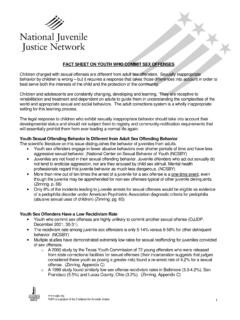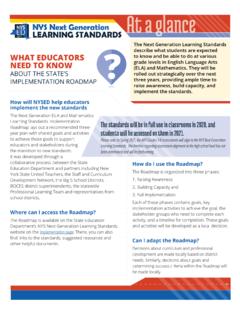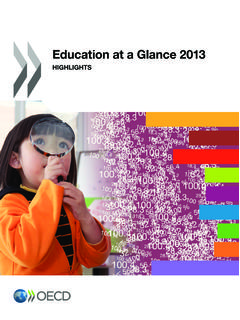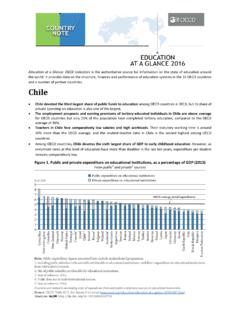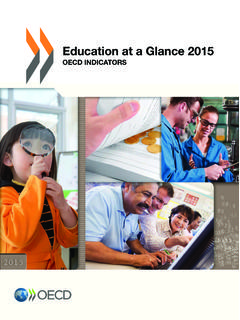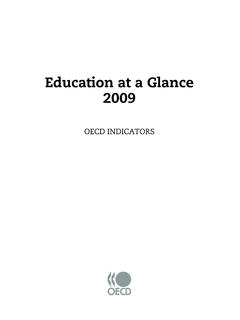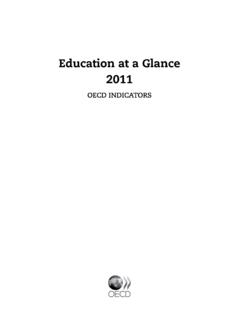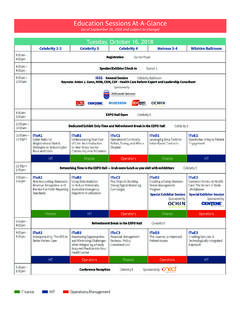Transcription of STANDARDS AT A GLANCE, 2019 Edition - acacamps.org
1 STANDARDS at a glance , 2019 Edition (AUGUST 2018) 1 STANDARDS at a glance , 2019 Edition This is a general overview of the 2019 version of the ACA STANDARDS . While each standard is listed here, the specific details, contextual education , to whom the STANDARDS apply, and compliance demonstrations are not included. STANDARDS at a glance is a basic reference. Camps or individuals who need complete, detailed STANDARDS information should refer to the Accreditation Process Guide, 2019 Edition , which can be ordered from the ACA Bookstore by calling 888-229-5745.
2 STANDARDS that are bold, red, and italicized are mandatory and camps must comply with these STANDARDS , as applicable, to be accredited by the American Camp Association. CORE Rights and Dignity of Campers/Staff: The camp should have a written statement specific to respecting the rights and dignity of all individuals that is shared with staff, parents/guardians, and campers, and that staff are trained to facilitate. Goals and Outcomes: The camp should have a written statement of goals, identify measurable outcomes, train staff to help campers achieve them, and inform parents and campers of these intended outcomes.
3 Camper Development: Camp programs should provide specific activities that are designed to help camper developmental, emotional, social, and physical health. Environmental Activities: The camp should offer program activities that help develop awareness of, appreciation and responsibility for, and stewardship toward the natural environment. Condition of Facilities, Equipment, and Vehicles: Buildings, structures, grounds, equipment (including vehicles, if applicable), and activity areas should be maintained in a clean, safe, and sanitary condition.
4 ADMINISTRATION Administration: Site/Transportation Local Emergency Response: The camp must make annual contact with all applicable local emergency officials to notify them of the camp s dates of operation and relevant scope of programming (including items such as clients served, key elements of the program, and overview of the facilities). Emergency Medical Transportation: If the camp does not use 911 for emergency medical transportation, the camp must have emergency transportation available at all times provided by the camp being accredited OR by the rental group.
5 Private Vehicle Use: The camp should obtain written permission from owners to use their private vehicles for camp business. Arrival and Departure: The camp should have and use procedures for an orderly arrival and departure of campers, for the loading and unloading vehicles, and supervision during these times. Transportation Information to Parents: Parents should be provided with written pick-up and drop-off times, including a system to communicate any changes, safety procedures, and safety rules for buses/vans. STANDARDS at a glance , 2019 Edition (AUGUST 2018) 2 Accident Procedures: A staff member trained on accident procedures should be in each vehicle transporting campers/staff.
6 Transportation Safety Procedures: Transportation procedures should include seating limits, required use of seat belts/booster seats, passengers remaining seated, and wheelchair-handling procedures when applicable. Transportation Orientation: The camp should orient all passengers to safety regulations and procedures. Driver Requirements: Driving records should be reviewed by the camp, and the camp should confirm that drivers have appropriate licenses for the vehicles driven. Leased, Rented, or Chartered Vehicles: The camp should select providers who include evidence that they have a system for regular maintenance/safety checks and that they verify acceptable driving records of provided drivers.
7 Administration: Health and Wellness Special Health Needs: The camp should provide parents of potential campers with special health needs information about the camp s philosophy and health management practices and should have a system to evaluate the camp s ability to meet special health needs, including providing sufficient health staff. Record Maintenance: All health-related forms and records should be kept for at least the period of statutory limits. Administration: Risk Management Risk Management: The camp should identify and analyze risk exposure and take risk control measures.
8 Incident Reporting and Analysis: Written reports on incidents and accidents should be completed and annually reviewed to modify or change procedures as necessary. Insurance Coverage: The camp should have applicable insurance coverage for general liability, worker s compensation, loss on buildings, business personal property, motor vehicles, and campers. Personal Property Policy: The camp should advise all participants of policies for possession and use of alcohol/drugs, personal equipment (sports, electronics, etc.), vehicles, animals, and weapons.
9 Non-Program Firearms Control: Firearms and ammunition not used in programs must be stored under lock. Camp Security and Active Threats: The camp should annually review security concerns, establish a written plan to address possible intruders and active threats, and train staff and campers in the steps to take. Safety Orientation and Emergency Plans: The camp should provide a safety orientation to campers, staff, and rental groups, regarding camp boundaries and hazards, behavior expectations, and emergency procedures for natural disasters and other reasonably foreseeable emergencies.
10 Missing Person Procedures: The camp should develop written search-and-rescue procedures for lost, missing, or runaway persons. Emergency Communications: The camp should have written procedures specifying a system for emergency communication when campers or staff are away from camp, for contacting parents/guardians of minors, and for communicating with the media. Campers in Public Areas: When campers are in public places or have contact with the public, the camp should specify supervision ratios, safety rules and behavior guidelines for campers, and emergency procedures if someone is separated from the group.
